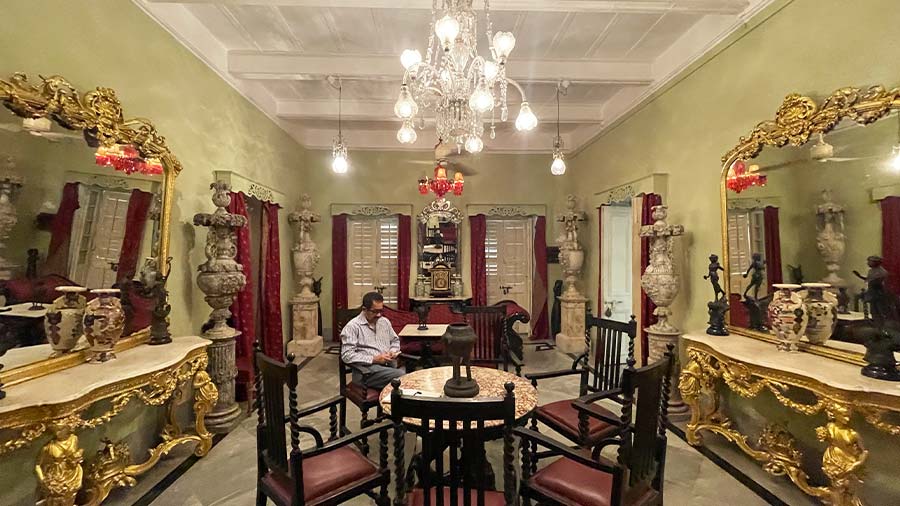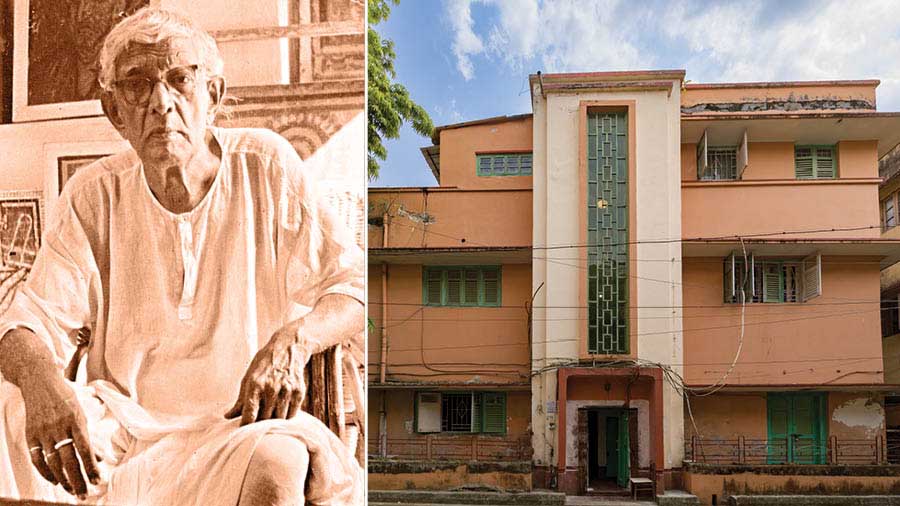The best way to Sukhatara is by stating a simple direction – ‘Abol-Tabol-er goli’.
Following a popular contiguous pujo on Nalin Sarkar Street, thousands walked past Sukhatara’s understated elegance (‘Ora ekhono ei-rokom rekhechhen, shetai to bodo kotha’) without appreciating the larger story of the location, residents and influences.
The relevant Sukhatara story begins in undivided India’s Khulna, on the other side of the Ichhamati River. The visionary scientist Dr Acharya Prafulla Chandra Ray had been invited to preside over the prize distribution ceremony at a local school. The visionary was surprised that each time a prize was announced for a subject, the boy who emerged would be the same. Normally, the chief guest would have patted the boy on the head, made a patronising remark and forgotten about it. But when this event ended, the celebrated scientist asked for the boy to be summoned. He probably also placed a hand on his head, but added, ‘Aamar shonge Kolkata aye. Okhane por!’
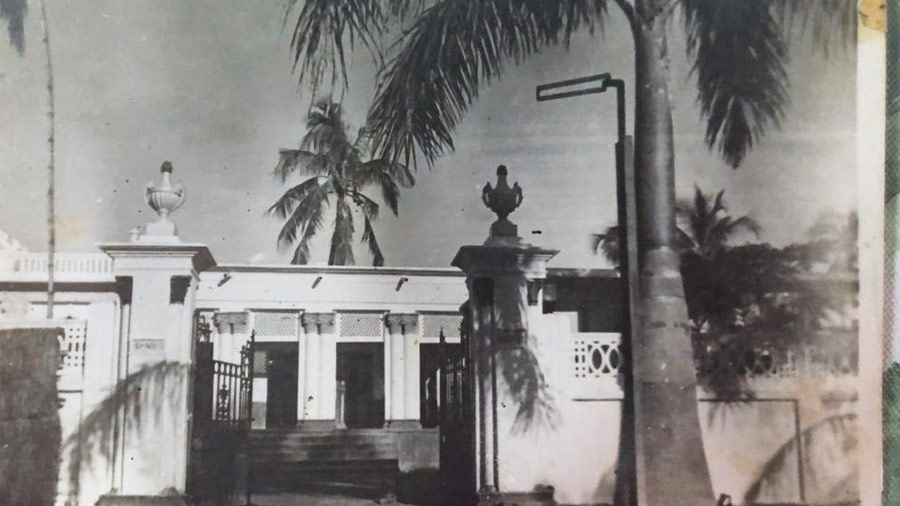
Part of the Khulna estate
The student, Baidyanath Sardar, migrated to Calcutta in the early Twenties. Initially, he stayed in some corner of the Science College campus in Rajabazar under the scrutiny of Dr Ray, the college’s founder. Later, a more functional arrangement was evolved: the student was ‘adopted’ by a Rajabazar family – as was the norm in a more empathic Calcutta where the wealthy usually took in a boy from the village – where he was provided a place to stay and food in exchange for two deliverables – he would be expected to run local errands and teach the children of the house (which officially made him a ‘contributor’).
Acharya Ray was not a visionary for nothing; the selected boy sustained his academic excellence in a more competitive metropolis. Some 95 years later, his descendants communicate a precise detail they may have heard repeated a number of times over: he stood ‘first class second in mathematics with a gold medal’. The operative words: ‘second’ and ‘gold medal.’ The description carries a story: Baidyanath would have come first if the appraisal had been on merit; a reverse reservation ensured that the first position would be traditionally reserved for a Brahmin student. The college recognised that Baidyanath’s rank represented a moral victory and awarded him a gold medal regardless.
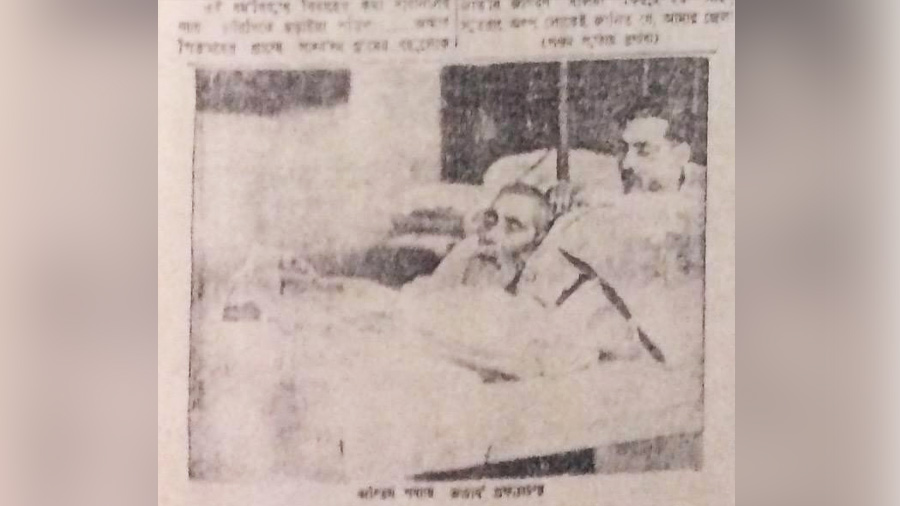
A newspaper clipping from 1944 showing Baidyanath Sardar with the mortal remains of Dr Acharya Prafulla Chandra Ray
That should have been the end of the mentor-protégé engagement (‘Bhalo korechhis! Majhe-majhe aashbi’) but for a small detail: Acharya Ray offered Baidyanath a job in Bengal Chemicals. Most proteges would have taken it to secure their professional existence. Baidyanath pitched higher; he selected to go into business instead (surgical dressing, gauze and bandage) mentored by the man whose job had been turned down. Baidyanath and brother Aurobindo grew this business (named after their deceased elder brother Bala Hari); by the early Forties they had created an enterprise successful enough to fund the acquisition of an estate in Noonnagar (Khulna). I was surprised: why would two entrepreneurs not choose to reinvest, but put their cash flows into a passive asset. The answer I got was that they did this to settle an emotional account: the humiliation of having been turned out from one of the pujo thakur-dalans of Khulna in childhood. The new acquisition was perhaps their way of telling the eco-system that they had entered a new social orbit. To seal this, a Durga Puja commenced on that Khulna property a year later by the younger brother following a clearance from the elder brother (the Sardars claim that theirs is possibly the only pujo among migrant Calcutta families to have continued uninterrupted since).
The Durga Puja is a recurring Sardar family motif. In 1955, the puja became the context for a structural family decision. The pujo was in progress at the Khulna estate when the Pakistan Army marched in. The army did nothing except assume positions and oversee the rituals but the very presence of the military in boots, guns and stares sent out a morse to the Sardar family: their time in this eight-year-old nation was up. The family never fled in the conventional sense; they locked their home and left for India. Saddened, but not distressed.
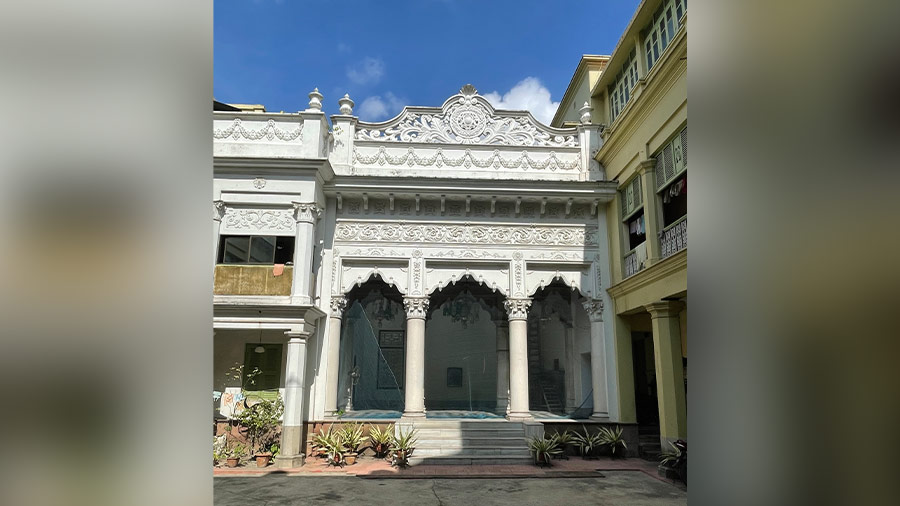
The ‘thakur dalan’ at Sukhatara
Seventeen years later, the Sardar family exploited a diplomatic window in a new country (Bangladesh) that permitted original residents to return. The entire family – 40 members – crossed the Ichhamati River from Taki to Khulna to re-connect with their zameen (it is amazing how they still considered it ‘their zameen’). This is what they discovered: the matriarch’s palanquin had been converted into a dwelling place for two; the nahabatkhana had become a ‘residence within a residence’ for four. The women wept. The family returned in a day. A closure had happened.
There is some of this Khulna in Sukhatara. The thakur-dalan carries the imprint of what the family left behind. There is a zamindari flavour from the driveway that makes this an unusually spacious property in the neighbourhood; the windows and balconies on the façade are decorative and not functional with no access from the room to these outlets; there is a castle-like terrace railing; there is a design motif on the vertical column of the entrance; there is a curved structure atop the entrance column that gives the impression that one is entering a ‘jayedaad’; the criss-cross of grilled staircases across two inside storeys could keep a photographer engaged; the sandstone elephants with extended trunks fitted into the upper end of the dalan entrance appear a bit incongruous, but welcome; the façade of the thakur dalan and pediment have been embroidered with embossed floral design; the colour theme is a consistent yellow and green.

There is a zamindari flavour from the driveway that makes this an unusually spacious property in the neighbourhood
And this is before one enters the ground floor hall. This hall represents the zeenat of Sukhatara. The large ornate gold framed mirrors, the marbled round centre table, the eight candlestands being probably the only ones of their kind in the city (with the ‘Except for Marble Place’ disclaimer); the red chandelier influences the room tint; the sofa has been upholstered in a stately maroon. And then the clock: my research was interrupted by the gong of ‘11’. The conversation stopped. My pen lifted. I shut my eyes. And waited.
Sukhatara comprises 22 bedrooms, 11 toilets, two halls, four domestic staff rooms and four kitchen-cum-dining spaces. There was a time when the garage comprised 14 cars: Rolls Royce, Oldsmobile, Studebaker Presidents and others; I am told, 'Today, we have only an Austin 7 tourer & Standard 10 Companion’ with a resigned air of a person who returns from vacation to discover that a relative has disinvested family silver.
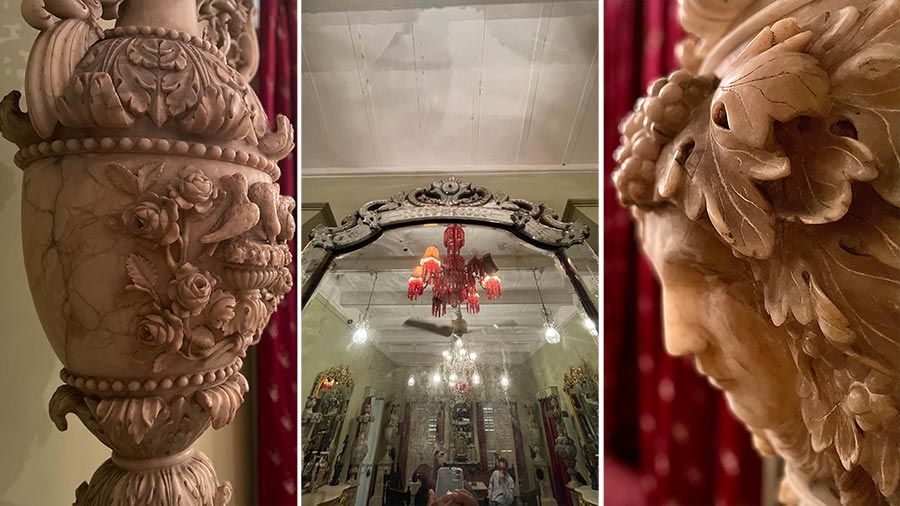
In the ground floor hall
Until the early Seventies, Sukhatara accommodated 60 relatives across three families; this has come down to 10, supported by 10 domestic helpers. There must have been a time when children slept in the floor of every room; today each family member can technically have two rooms to himself/herself. The Sardars grew up within an inbuilt support system that comprised generations of family members; culture of sharing (what may have been brought for one child was by shared by all); empathy became a family reflex response; there was a large sense of positive ego (‘I am a Sardar, how could I even think of doing this?’); accommodations and adjustments were every day and everyplace.
These values transmuted to a ‘fierce property pride’. It is like ‘If we can protect the property, a large part of our values may also be preserved.’ To protect the bequest across the coming generations, the Sardars have evolved a code. One, virtually nothing will be changed on the inside even if it pains (rather than restructure the property to accommodate an attached water closet, one of the co-owners shifted residence to Salt Lake and lives only 30 days a year in the house he still considers home). Two, while repairs are permitted, ‘improvements’ are not. Three, the home will not be commercially monetised, which means no renting for film shootings. Four, a concession has been the deployment of air-conditioners and with the exception of a solitary box on the roof visible from the street, the other boxes have been concealed.

The windows and balconies on the façade are decorative and not functional
I come back to the Durga Puja. At one time, this pujo drew more than 100 relatives to Sukhatara; with families having dispersed, this has declined to 50. Descendants indicate pride coupled with responsibility: pride at having sustained a family tradition with no diminution in detail or devotion; responsibility in ensuring its sustenance. There is something more interesting: large joint families like the Sardars are difficult to sustain on account of diverse opinions and an increasing accommodation of ‘democratised opinion’ that often wishes that the erstwhile command structure was back. There is something else that the Sardars tell me: ‘We may have different opinions and may not see eye to eye on most things, but the Durga Puja miracle is that for 10 days, there is an unannounced truce: no one discusses family business, no one discusses dissenting points, and no one complains. It is like one large happy family. This is the biggest grace of the pujo at Sukhatara.’
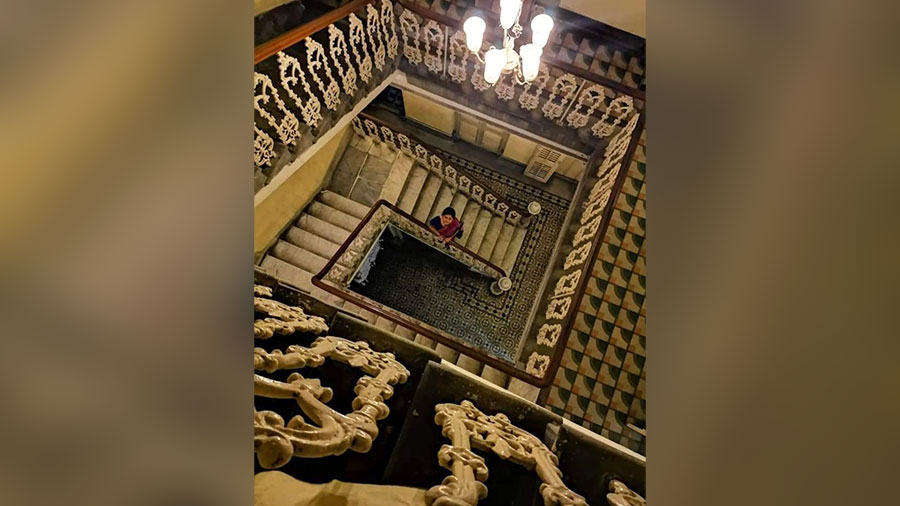
The grilled staircase across two storeys
What are my take-homes from Sukhatara? Clearly three. That the stories of families need to be recorded in a world of declining attention spans. That the real Calcutta lives in the ‘Nalin Sarkars’ of the city where the smell is still ‘1935’. That built heritage conceals unspoken yearnings of a land so romantically described by ancestors that the family elders of the day dream that they will one day be able to take their children to a crumbling mansion next door, if only to show them once so that they never forget.


